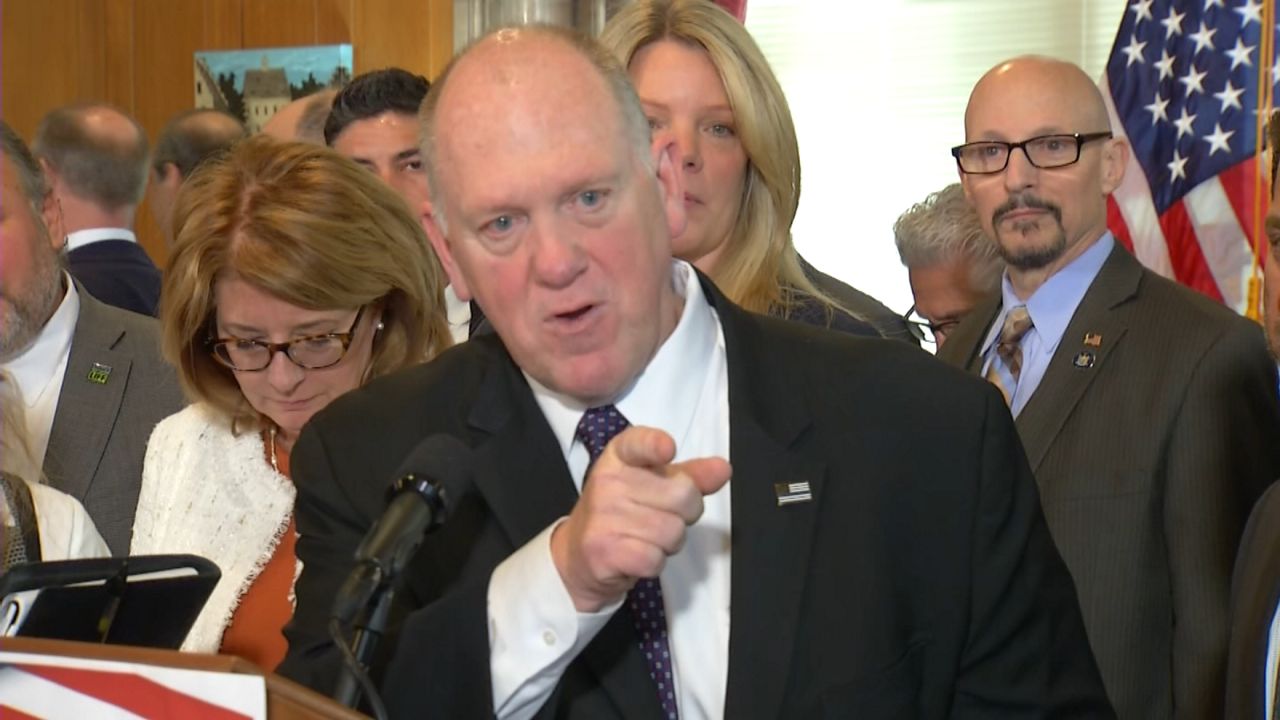Every day, Judge Mimi Tsankov heads to Lower Manhattan for her typical day that is so busy it’s not uncommon to miss lunch.
As busy as she is, the stakes for the people coming before her are very high.
What You Need To Know
- From March 1 through May 31, 2023, 38,765 migrants have arrived in New York City — the most in the country by more than two times
- An immigration judge says they are constantly trying to reduce the backlog but cases are only growing
- Judge Mimi Tsankov said the fact that the immigration court is not independent has caused problems
Will they be allowed to stay in the United States? Or will they be forced to leave?
Many are migrants seeking asylum in the U.S.
Tsankov is an immigration judge based out of 26 Federal Plaza in New York City.
“We really are on the bench all the time trying to chip away at the volume of work that’s pending before us,” she said.
The pile of work only seems to grow.
According to the Syracuse University’s Transactional Records Access Clearinghouse, which compiles federal immigration data, from March 1 through May 31, 2023, 38,765 migrants have arrived in the city — the most in the country by more than two times.
The number of asylum cases pending in New York is only growing.
There are 115,367 pending cases throughout New York state — nearly all in New York City, according to TRAC.
That’s up about 4,000 cases from October 2021 to September 2022.
A decade ago, that number was 30,534.
Presidents Donald Trump and Joe Biden have both earmarked more money to hire additional immigration judges.
Right now, there are 78 judges in the city.
Tsankov said she’s not sure how many more are needed to fill the growing backlog of cases.
“I can’t give you the silver bullet of what the number is,” she said.
That’s because she said they need more than just judges. It’s more judicial clerks, staff and interpreters, in order to hear and process more cases faster.
It can take years for asylum seekers, for example, to go before an immigration judge.
The average time from filing an asylum application to the hearing in New York City is more than three years, according to TRAC.
But NY1 has spoken with asylum seekers with cases pending closer to eight years.
Tsankov spoke with NY1 in her capacity as president of the National Association of Immigration Judges, a union she speaks passionately about, yet with a future that is much less certain.
She’s been an immigration judge for 17 years and gave a glimpse into what her day is like.
She hears immigration cases at 8:30 a.m., 10 a.m., 1 p.m. and 2:30 p.m. By the end of each hearing, she usually has to have a decision.
“Rendering an extemporaneous, oral decision that can sometimes take 45 minutes to an hour that synthesizes all the documents that have been submitted is challenging under any circumstances,” she said.
But she said she never feels like she rushes a decision.
“I don’t make a decision unless I am certain I have devoted the time,” she said.
However, she said the way the system works; it puts pressure on judges — particularly new ones.
She said they are on what she referred to as probation for two years, where they can be fired for any reason within that timeframe.
“The new judges, I think, struggle with the tension between pleasing management and making sure they are constantly fair with all the decisions they have to make on the bench and that’s why we really want to support them,” she said.
Until recently, there had been a quota for how many cases each immigration judge must decide, determined by the Department of Justice.
During the Trump administration, the bar was set at 700 cases per year.
The Biden administration removed the requirement. However, Tsankov said a dashboard that checks their progress remains intact.
She said it shows red for not meeting the quota and green for doing so.
“We’re not sure to what degree the agency is looking at that though and taking that into consideration whether we are meeting expectations,” she said.
The immigration judges are appointed by the Attorney General of the United States.
They fall under the umbrella of the Department of Justice, specifically the Executive Office for Immigration Review (EOIR).
A spokeswoman from DOJ denied that the dashboard is used to monitor the judges’ case count.
“The dashboard plays no role in evaluating immigration judges’ performance, and all judges are aware of that,” she said in an email to NY1.
“The dashboard is now used solely to allow immigration judges to view information about their workloads and assist the agency in providing aggregate data about the immigration court workload nationwide,” the spokeswoman added.
Tsankov said the fact that the immigration court is not independent has caused problems.
For example, she said they have little control over the cases that come before them — or how many.
“We see that the administration, multiple administrations over time, have manipulated the types of cases that we ultimately have appearing before us and our ability to administratively close cases if we believe that it warrants that,” she said.
Rules for immigration judges can change from one administration to the next.
For example, the Trump administration ruled victims of domestic and gang violence are ineligible for asylum.
The Biden administration reversed that.
In the spring, the Biden administration declared most people crossing the southern border would be ineligible for asylum if they never tried to receive asylum in any other country they traveled through to reach the United States. One exception to the rule is by using the U.S. Customs and Border Patrol app to present themselves at a port of entry at a determined time and place.
Tsankov said she believes the immigration court should be independent of the DOJ.
Last year, a bill in Congress would have done just that. However, it never moved forward.
Rep. Jerry Nadler, who represents Manhattan, was a co-sponsor of the legislation.
“We do not have any information on plans for reintroduction,” a spokesperson emailed NY1.
California Rep. Zoe Lofgren filed the bill last year and will be filed again, according to a source familiar with her thinking.
Tsankov said she believes giving power to her union, the National Association of Immigration Judges, could also make a difference.
In April 2022, the Federal Labor Relations Authority decertified the union.
“The Authority found that [immigration judges] are management officials, and, therefore, directed the Regional Director (RD) to exclude [immigration judges] from the bargaining unit,” wrote James Abbott, a FLRA member.
However, there is an ongoing court battle in an attempt for NAIJ to get its status back.
“It’s critical we get our status back because when you are trying to manage a docket, you really want to have not just management deciding how they’re going to assign the work but taking into consideration what the judges on the ground know is actually the challenge that they’re facing,” said Tsankov. “So we need good conversations around how to resolve the problems facing our courts.”
Quick fixes may not be in sight for an immigration system with a backlog growing year after year.
In the meantime, Tsankov will report to 26 Federal Plaza tomorrow, as she does every day, to hear four more cases at immigration court.








_Dnt_NYIC_Immigration_Clean)
_PKG_Churches_Sheltering_Migrants_CLEAN_132766675_0)